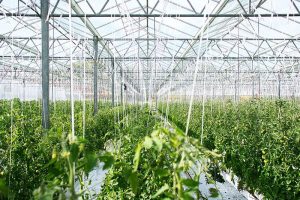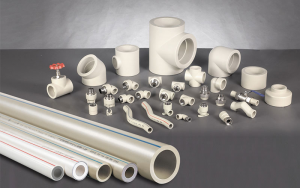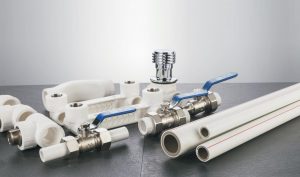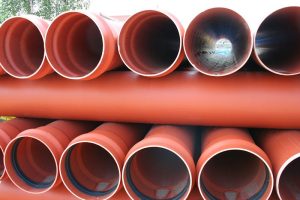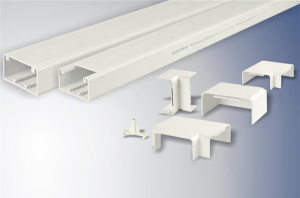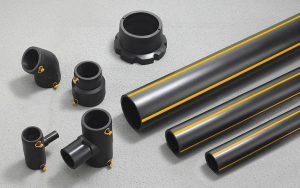Table of Contents
Plastic pipes play a crucial role in modern construction and industry due to their corrosion resistance, lightweight, long service life, etc. They are widely used in fields such as water supply, drainage and sewage treatment, agricultural irrigation, and cable insulation.
Two main plastic materials for such piping needs are PVC (polyvinyl chloride) and HDPE (high-density polyethylene). Both types of pipes have similarities in terms of chemical resistance and physical properties, but there are significant application preferences.
Therefore, correctly identifying the difference between PVC vs. HDPE is important before selecting suitable pipe materials for projects.
Understanding PVC and HDPE Pipes
In the HDPE pipe vs. PVC pipe comparison, both types are excellent options for many applications. However, certain properties differ between the two materials.
1. What are PVC Pipes?
PVC pipes are extruded pipes mainly made of polyvinyl chloride resin, with necessary additives such as stabilizers, lubricants, and fillers added.
It is an important component of modern liquid transportation systems and has good corrosion resistance to most chemicals, such as acids, alkalis, and salts. Due to its excellent tensile and compressive strength, PVC pipes can adapt to applications in various industries.
2. What are HDPE Pipes?
HDPE pipes are extruded pipes made of high-density polyethylene resin. It is also widely used in modern fluid transportation and is known for its excellent impact strength and heat resistance.
Due to its higher density and melting point in the PVC vs. HDPE comparison, it is highly suitable for applications with complex and demanding environments. For example, HDPE pipes are commonly used for industrial fluid transportation and hot water delivery.
What are the Differences Between HDPE and PVC Pipes?
While both PVC and HDPE pipes serve construction and industrial needs well, understanding the key differences in their properties is important:
1. Mechanical Properties
Compared to PVC pipes, HDPE pipes are made of high-density polyethylene and have a higher tensile strength, typically greater than 3500 psi. [1] This allows it to withstand high-tensile forces without breaking. The tensile strength of PVC pipes is related to temperature. It will decrease when the temperature increases, and vice versa.
In terms of pressure class, both HDPE and PVC have good compressive strength. However, HDPE usually has a higher pressure rating and better stress-cracking resistance than PVC.
In addition, HDPE pipes have high flexibility and can be bent without the need for additional fittings. It can be flexibly installed in different environments. PVC pipes also have good flexibility but are more prone to damage than HDPE pipes.
2. Joining Methods
PVC pipes can be connected through cement, adhesive, mechanical fittings, or threaded connections. It features simple connection methods but may require some additional fittings. It ensures reliable sealing that is not easy to leak.
HDPE pipelines are connected using heat fusion or electrofusion welding. This requires specialized heat fusion or electrofusion equipment suitable for large pipes and industrial applications. This is a major PVC vs. HDPE difference.
3. Chemical Resistance
For the PVC vs. HDPE comparison in chemical resistance, PVC and HDPE pipes have good resistance to most chemicals and corrosive substances, making them widely used in chemical industry applications. It can withstand the erosion of various chemical substances, including acids, alkalis, and salts.
However, in some strongly acidic and organic solvent environments, the chemical stability range of HDPE pipes is wider than that of PVC pipes.
4. Temperature Resistance
The temperature limit range for HDPE pipes to maintain mechanical properties is approximately -40 ° C to 80 ° C (-40 ° F to 176 ° F). [1] The upper-temperature limit for PVC pipes is 60 °C. [2]
Therefore, HDPE pipes can maintain their physical properties at lower temperatures without cracking and are also superior to PVC pipes in high-temperature applications.
5. Environmental Impact
HDPE and PVC pipes are non-toxic and pollution-free. In this PVC vs. HDPE comparison, both pipes are considered environmentally friendly options.
The recycling method for HDPE pipes is to remove nonplastic fragments and then separate them according to density. They will be shredded, melted, made into plastic pellets, and then recycled by the manufacturer.
For PVC pipes, if lead-containing plasticizers and other additives are used in the production process, they may not be recyclable. But for lead-free PVC pipes, PVC can be ground into small particles and cleaned before being remade into new products. In addition, waste can be converted into reusable components through various chemical processes such as pyrolysis or hydrolysis. [3]


Different Applications of PVC and HDPE
Understanding where each material performs best aids in selecting the right pipe type from PVC vs. HDPE for projects. Here is an analysis of the applications:
1. Application of PVC Pipes
PVC pipes are well-suited within buildings and infrastructure due to their chemical resistance, weather resistance, and low friction coefficient. Some key uses include:
- Water supply networks
- Sewage and drain systems
- Industrial plumbing
- Agricultural irrigation
- Air conditioning system
- Cable protection
2. Application of HDPE Pipes
HDPE pipelines are advantageous for requirements involving flexibility and minimal environmental impact. Common usages that set them apart in the PVC vs. HDPE comparison include:
- Non-pressure agricultural irrigation
- Landfill leachate collection
- Drainage systems
- Marine applications
- Process chemicals
- Natural gas transmission
PVC and HDPE Pipes from Lesso
As a premier piping solutions company, Lesso offers high-quality PVC and HDPE pipes and fittings for construction and industrial uses. Our range caters to requirements ranging from potable water, sewage, electrical conduit, cable protection, and drainage.
Regardless of which you choose, PVC vs. HDPE, our piping systems cater to an array of construction and industrial applications.
Our typical PVC pipes include:
- PVC-U Water Supply Pipes are suitable for municipal, commercial, and residential water supply, industrial liquid transportation, and sewage treatment. They are environmentally friendly and corrosion-resistant, with smooth inner walls and a service life of over 50 years, making them the preferred water supply solution.
- PVC Conduit and Fittings are ideal for protecting electrical wiring installed within concrete structures. They are non-conductive with fire resistance, corrosion resistance, high impact strength, and good breakage resistance, providing long-lasting worry-free protection.
Our typical HDPE pipes include:
- PE Water Supply Pipe is also the preferred solution for water supply and wastewater treatment. In addition to good corrosion resistance, flow capacity, flexibility, and impact resistance, it also has excellent UV resistance, differential settlement resistance, etc. This makes it reliable enough for more than 50 years of use in the future.
- HDPE Double-Wall Corrugated Pipe and Fittings are durable for conveying wastewater, sewage, and subsurface drainage over long distances. If you want an environmentally friendly and cost-effective water supply or drainage solution, then it is a good choice.
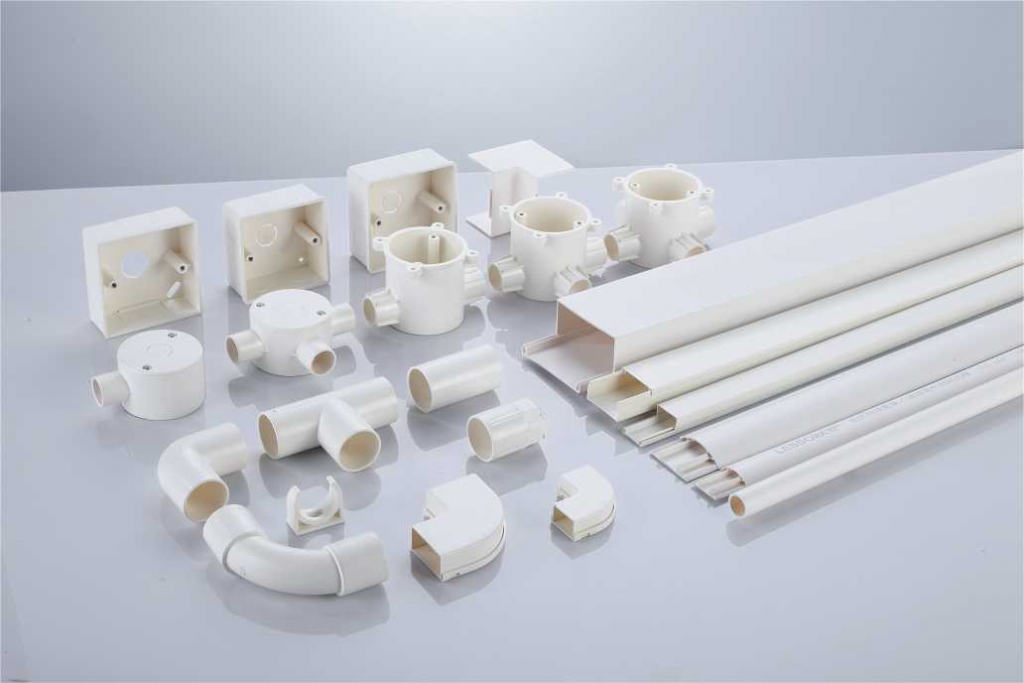

Conclusion
Overall, the PVC vs. HDPE comparison highlights several key differences. PVC remains the most prevalent plastic piping material in building services. HDPE excels in applications requiring flexibility, temperature tolerance, or high-pressure usage.
Lesso offers reliable solutions in both categories. We meet various industry and infrastructure needs via our reliable products. Contact us to learn more about the difference between HDPE and PVC, and browse our full range of products.
References
[1] What is HDPE Most Commonly Used for? Available at: https://en.lesso.com/blogs/hdpe-most-commonly-used-for/ (Accessed: 21 August 2024)
[2] How Temperature Affects PVC Pipe. Available at: https://en.lesso.com/blogs/how-temperature-affects-pvc-pipe/ (Accessed: 21 August 2024)
[3] Everything you need to know about PVC recycling. Available at: https://extruflex.com/everything-you-need-know-about-pvc-recycling (Accessed: 21 August 2024)



